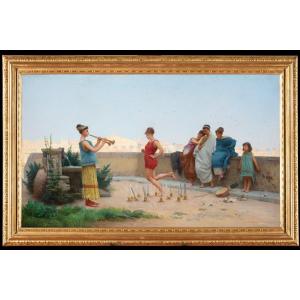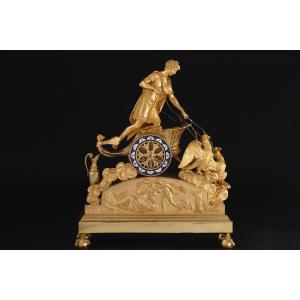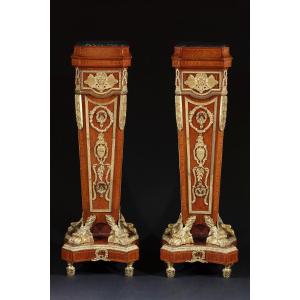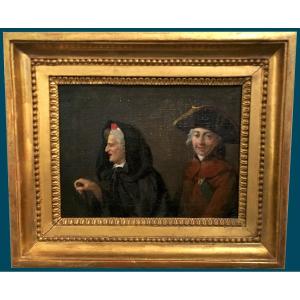The large painting depicts a genre scene, typical of the artist's most prolific period; the subjects, immersed in the rich and expertly constructed glimpse of a Venetian alley, are intent on curiously observing the tiles of the game of tombola, while a commoner, seen fleetingly, looks at the horizon creating a caesura in the scene with her body and aquamarine skirt: the figures in the foreground, dressed in brighter colors, stand out in the center of the work, isolating themselves and shining with a lively chromatism that separates them from the landscape made of earthy grays and warm, mild hues. The lively naturalness of the subject is made tangible by the presence of small farmyard birds, such as chickens and ducks, whose feathers are skillfully rendered by Lancerotto with tender, elongated brushstrokes; the large basket in the foreground, full of the fruits of the earth, helps to place the scene in a genuine, simple, peasant context. The village people of Lancerotto, immortalized on canvas by his attentive gaze, live in a perpetual and wonderful Idyll, as if instead of coming from Venice they were originally from Arcadia. The painting is cited in the XXII edition of “Il valore dei dipinti dell’Ottocento” by Giuseppe L. Marini on page 464-465.
Egisto Lancerotto was born in Noale in 1847 to a middle-class family; his father was a civil servant and his job forced the large family to move constantly. In 1853 they returned to Venice, his hometown. As he grew up, Lancerotto showed an inclination towards painting and at the age of twenty he enrolled at the Academy of Fine Arts in Venice: his career was so brilliant that he was awarded several times; in 1874 he received an honorable mention for artistic progress following the presentation of "four praiseworthy paintings".
The artist
As an academy artist, he also personally experienced the stylistic changes that this institution was going through in less than a century, moving from neoclassicism to Romanticism in the following decades, until he was infected by the new veristic current; However, few works remain from Lancerotto’s youthful activity, including a large historical painting from 1883, “The Siege of Florence”, made on a cartoon awarded during his academic studies about ten years earlier. This subject, however, is unique in Lancerotto’s painting, who begins to devote himself full time to verist themes, following in the footsteps of his teachers, the most important painters of the Venetian school of his time, including Napoleone Nani, Antonio Bresolin, Federico Moja and Pompeo Marino Molmenti.
Together with his contemporaries, including Nono, Bianchi, Ciardi and above all Favretto, with whom he establishes a long friendship, Lancerotto is part of the “young Venetian school”, as Molmenti defines it. It was precisely in the 1880s that he reaches his artistic maturity as well as his critical success, with his numerous genre paintings: Lancerotto manages to capture the spirit of the Venetian people, entering into the heart of the somewhat romanticized daily life of the village; in his scenes the characters and their relationships are always the focus of the painting, painted with broad brushstrokes; outdoor scenes are frequent, especially marine ones, but more common are canvases in which the setting is internal. Lancerotto's subjects are lively and full of life, apparently real and fresh, as if just collected from the alleys of the lagoon itself, but then broken down, reworked and polished in his atelier. In this period he was invited to the exhibitions of the Società Promotrici of Venice and Milan, where he made himself known with works such as "Maternal happiness", exhibited in Brera in 1886 or "Regatta in Venice" of 1887, of which two versions are known, one at the GAM in Genoa, the other preserved in the Civic Collection of Noale.
Gifted with a great spirit of observation, Lancerotto investigates with great efficiency the psyche and feelings of his subjects, a gift also acclaimed by the critics of his time, as demonstrated by some testimonies that speak of an artist with a very conspicuous and fruitful production.
His vernacular nature was appreciated at various exhibitions by Italian but especially foreign buyers: Lancerotto won over collectors with the narrative vein of his subjects and the young women he portrayed, with exquisitely Mediterranean features, such as those in the “Due popolane ai giardini”, a canvas presented at the 1883 Rome Fine Arts Exhibition or “La Zingara”, sold at Brera in 1885.
His fame reached exhibitions throughout Italy, sending paintings to Turin, Florence, Rome, Bologna, Genoa, Verona and in particular to Ferrara, where he had established an advantageous relationship with the Benvenuto Tisi da Garofalo Art Society, which allowed him a prominent position during the Ferrara exhibitions until 1910, as well as his participation in foreign exhibitions, such as Paris, Nice, London, Antwerp and Munich.
Following the first International Exhibition in Venice in 1895, Lancerotto began to feel the need to renew himself; his painting, so fruitful up to that point, was now characterized by a continuous re-proposal of stereotyped themes and subjects, which in the long run were perceived by his contemporaries as stale and even commonplace. In fact, the four subsequent editions of the Biennale rejected his work “Chioggiotti in porto”.
From this moment on, Lancerotto gradually withdrew from his exhibition career, dedicating himself to pictorial experimentation and teaching in his studio; his brushstrokes became broad and dense, accompanied by a continuous search for surface effects, which was expressed in the alternation of heavy and pasty areas with sparser points of pictorial matter: the subjects lost plasticity and became almost ethereal, immaterial. Unfortunately, his attempts at modernization were judged negatively by contemporary critics.
At the beginning of the twentieth century, Lancerotto, driven by the need to refresh his expressive dimension, traveled several times to Brianza, Lombardy, where he continued to hold courses for young bourgeois women in his atelier; meanwhile he hangs out with his colleagues in the area, such as the naturalist Leonardo Bazzaro and Emilio Gola, a Lombard impressionist: the comparison leads him to study works of symbolist and divisionist sensibility, questioning himself and the constraints of that nineteenth-century painting with which he had trained and grown as an artist. For his part, unlike many of his contemporaries, there is the will to explore and go beyond his own pictorial and thematic limits, even if with a contradictory and unorthodox approach.
In 1910 the artist is struck by a lung disease, which forces him to interrupt his travels; after frequent hospitalizations, two years later he moves to the Lido in Venice in a newly built house-atelier, which was offered to him by the engineer and entrepreneur Giuseppe Sicher; one of the latter's daughters, Lia Sicher, was a student of the artist in his studio and later she will become a painter. Other traces of the acquaintance between the Sicher family and Lancerotto are the “Portrait of Adele Sicher”, daughter of Giovanni, represented full-length, while wearing a purple dress, whose cut, accentuated by the proud and slightly inappropriate pose, highlights the model’s curves; for this reason the family refused the work which therefore remained in his studio. Following Italy’s entry into the war and the attack by the Austrians of the coastal area of the province of Venice, Lancerotto returned to his Noale, where he later died, in poverty, in May 1916; his funeral took place in the presence of numerous representatives of Venetian high society and many artists. His works are today mainly preserved in the Ca’ Pesaro museum in Venice and in the civic collection of the city of Noale, left as a gift by Lancerotto himself in his will.




























 Le Magazine de PROANTIC
Le Magazine de PROANTIC TRÉSORS Magazine
TRÉSORS Magazine Rivista Artiquariato
Rivista Artiquariato